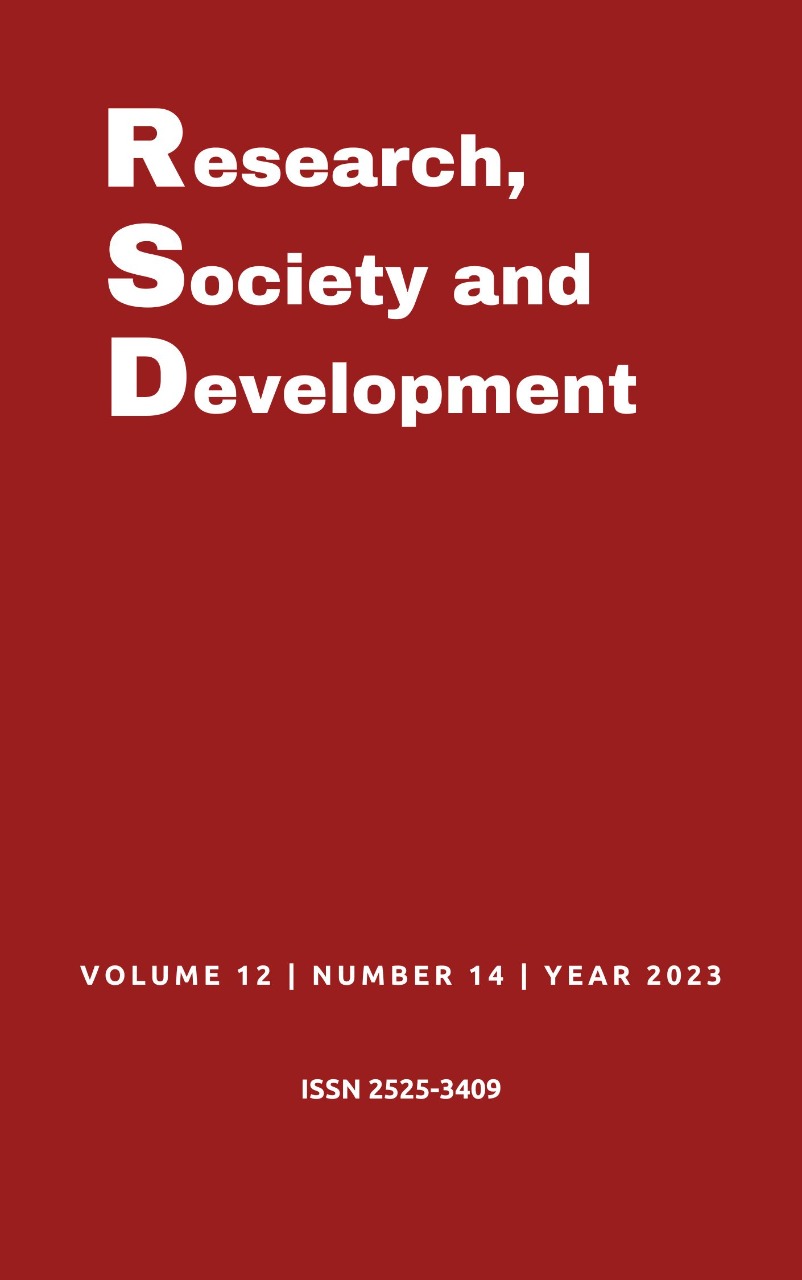Urinary sedimentoscopy findings in normal physicochemical examinations of dogs
DOI:
https://doi.org/10.33448/rsd-v12i14.32339Keywords:
Urinalysis, Sedimentoscopy, Physicochemical exams.Abstract
Urinalysis is the third most requested laboratory test by veterinarians. Because it is less invasive and cheap, in addition to adding to the early diagnosis of renal dysfunctions. Composed of physical, chemical and sediment exams. Thus, the main objective of the present work was to evaluate the importance of sedimentoscopy in relation to the normal values obtained in the physical-chemical exams. The study was constituted from the epidemiological survey of the results of 137 urine tests performed at the Veterinary Clinical Center of UNIPAM. Among the analyzed groups, the offspring showed significant alterations in the parameters: protein 66.66% (2/3), scaly cells 66.66% (2/3) and bacteria 66.66% (2/3). In adults, protein 92% (23/25), bacterial flora 84% (21/25) and turbidity 92% (23/25). And in the elderly, alterations were observed for bacterial flora 78.78% (26/33), turbidity 81.81% (27/33), leukocytes 78.78% (26/33) and red blood cells 75.75% (25 /33). It was observed that 17 samples (12.41%) did not present physicochemical alterations. Of these, 64% had some indication of abnormality in the sediment examination, with high relevance if the pathological findings are analyzed separately. For various reasons of improper handling of urine, physical-chemical examinations may present incorrect results. Therefore, in sedimentoscopy the findings are reliable and contribute to the diagnosis.
References
Bolodeoku, J. & Donaldson, D. (1996). Urinalysis in clinical diagnosis. Journal of clinical pathology, 49(8), 623-6. http://dx.doi.org/10.1136/jcp.49.8.623
Bush, B. M. (2004). Interpretação de resultados laboratoriais para clínicos de pequenos animais. Roca.
Chew, D. J. & Di Bartola, S. (1998). Interpretación del urianálisis canino y felino. Gloyd Group.
Costaval, J. A., Massote, A. P., Cerqueira, C. M. M., Costaval, A. P., Auler, A., & Martins, G. J. (2001). Qual o valor da sedimentoscopia em urinas com características físico-químicas normais? Jornal brasileiro de patologia e medicina laboratorial, 37(4), 261-5. https://doi.org/10.1590/S1676-24442001000400007
Garcia-Navarro, C. E. K. (2005). Manual de hematologia veterinária. Varela.
Heggendornn, L. H., Silva, N. A., & Cunha, G. A. (2014). Urinálise: a importância da sedimentoscopia em exames físico-químicos normais. Revista eletrônica de biologia, 7 (4), 431-43. https://revistas.pucsp.br/index.php/reb/article/view/20177
Hendrix, C. M. (2006). Procedimentos laboratoriais para técnicos veterinários. Roca.
Lima, A. L. M., Amóra, S. S. A., Filgueira, K. D., Feijó, F. M. C., Alves, F. R. P., Franklin, A. S., & Alves, N. D. (2005). Análise dos parâmetros bioquímicos e urinários de cães com suspeita de afecção do sistema urinário. Ciência animal, 15(1), 43–7. http://www.uece.br/cienciaanimal/dmdocuments/Comunicacao1.2005.1.pdf
Matias, M. A. N. (2015). Avaliação do desempenho das tiras Aution 10PA® na deteção de proteína e rácio UPC alterado na urina de cães e gatos. [Dissertação de mestrado, Universidade de Lisboa]. https://www.repository.utl.pt/handle/10400.5/8014
Mundim, A. V. (2007). Morfofisiologia renal e interpretação do exame de urina. [Apostila, Departamento de medicina veterinária da universidade federal de Uberlândia].
Mundt, L. A. & Shanahan, K. (2012). Exame de urina e de fluidos corporais de Graff. Artmed.
Nóbrega, B. P., Lima, L. J. L., Fonseca, D. V., Tenório, A. P. O., Tenório, P. P., & Lopes, M. R. (2019). A importância da análise sedimentoscópica diante dos achados físico-químicos normais no exame de urina. Revista brasileira de análises clínicas, 51(1), 58-64. https://doi.org/10.21877/2448-3877.201900785
Pereira, A. S., Shitsuka, D. M., Parreira, F. J., & Shitsuka, R. (2018). Metodologia da pesquisa científicaUFSM.
Pereira, S. B., Grol, A. A. V., Conte, C., Gil, L. F. A., Krause, L. E. B., & Meinerz, A. R. M. (2019). Avaliação retrospectiva da urinálise e mensuração de creatinica sérica como métodos auxiliares no diagnóstico de doença renal crônica em paciente caninos. Science and animal health, 7(2), 134-6. https://doi.org/10.15210/sah.v7i2.15080
Pöppl, A. G., & González, F. H. D. (2005). Aspectos epidemiológicos e clínico-laboratoriais da Diabetes Mellitus em cães. Acta scientiae veterinarie, 33(1), 33-40. https://doi.org/10.22456/1679-9216.14436
Sociedade Brasileira de Patologia Clínica - Medicina Laboratorial. (2018). Recomendações da sociedade brasileira de patologia clínica e medicina laboratorial: Fatores pré-analíticos e interferentes em ensaios laboratoriais.
Schmidt, J., Fam, A. L. D’A., Santos, C. C. P., & Rocha, R. S. (2016). Diagnóstico Laboratorial de Doença Renal: Revisão. Revista Eletrônica Biociências, Biotecnologia e Saúde, 15, 190-2. https://revistas.utp.br/index.php/GR1/article/view/1668/1414
Simerville, J. A., Maxted, W. C., & Pahira, J. J. (2005). Urinalysis: a comprehensive review. American family physician, 71(6), 1153-62. https://pubmed.ncbi.nlm.nih.gov/15791892/
Strasinger, S. K., & Lorenzo, M. (2009). Urinálise e fluidos corporais. Editorial Premier.
Thrall, M. A., Weiser, G., Allison, R. W., & Campbell, T. W. (2015). Hematologia e bioquímica clínica veterinária. Guanabara Koogan.
Downloads
Published
Issue
Section
License
Copyright (c) 2023 Júlia Fernanda Menezes Borges; Mariana Assunção de Souza

This work is licensed under a Creative Commons Attribution 4.0 International License.
Authors who publish with this journal agree to the following terms:
1) Authors retain copyright and grant the journal right of first publication with the work simultaneously licensed under a Creative Commons Attribution License that allows others to share the work with an acknowledgement of the work's authorship and initial publication in this journal.
2) Authors are able to enter into separate, additional contractual arrangements for the non-exclusive distribution of the journal's published version of the work (e.g., post it to an institutional repository or publish it in a book), with an acknowledgement of its initial publication in this journal.
3) Authors are permitted and encouraged to post their work online (e.g., in institutional repositories or on their website) prior to and during the submission process, as it can lead to productive exchanges, as well as earlier and greater citation of published work.


